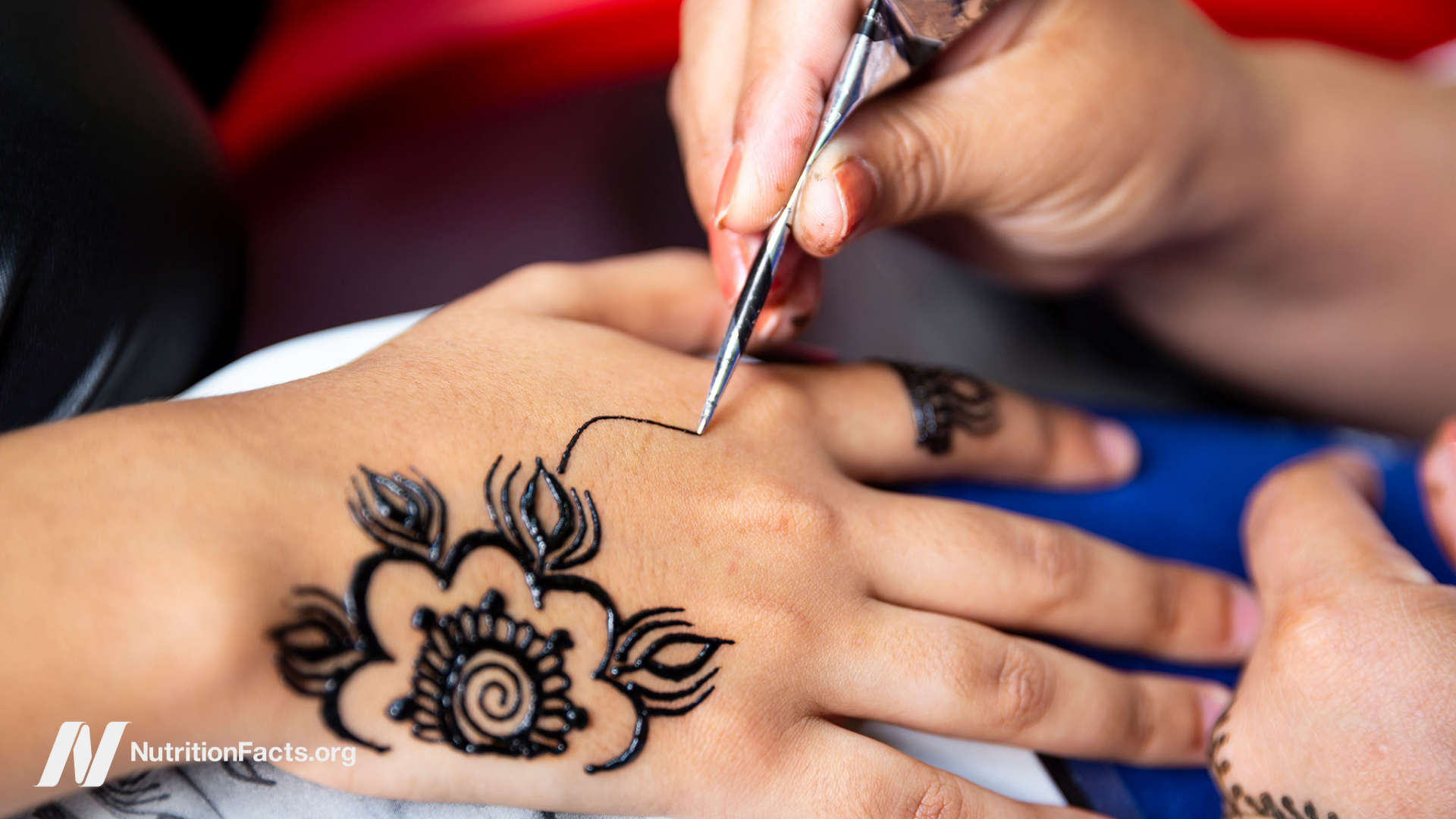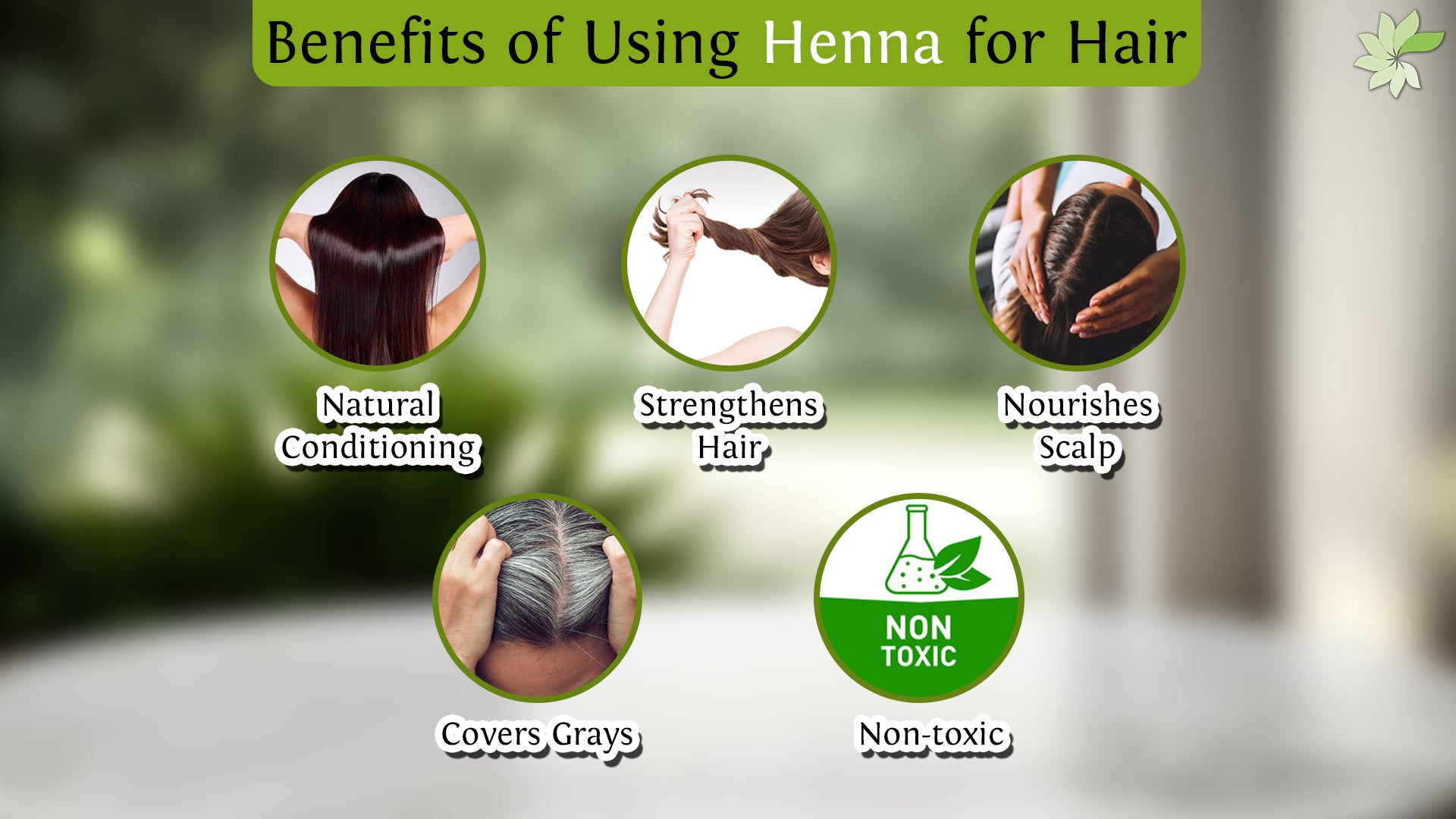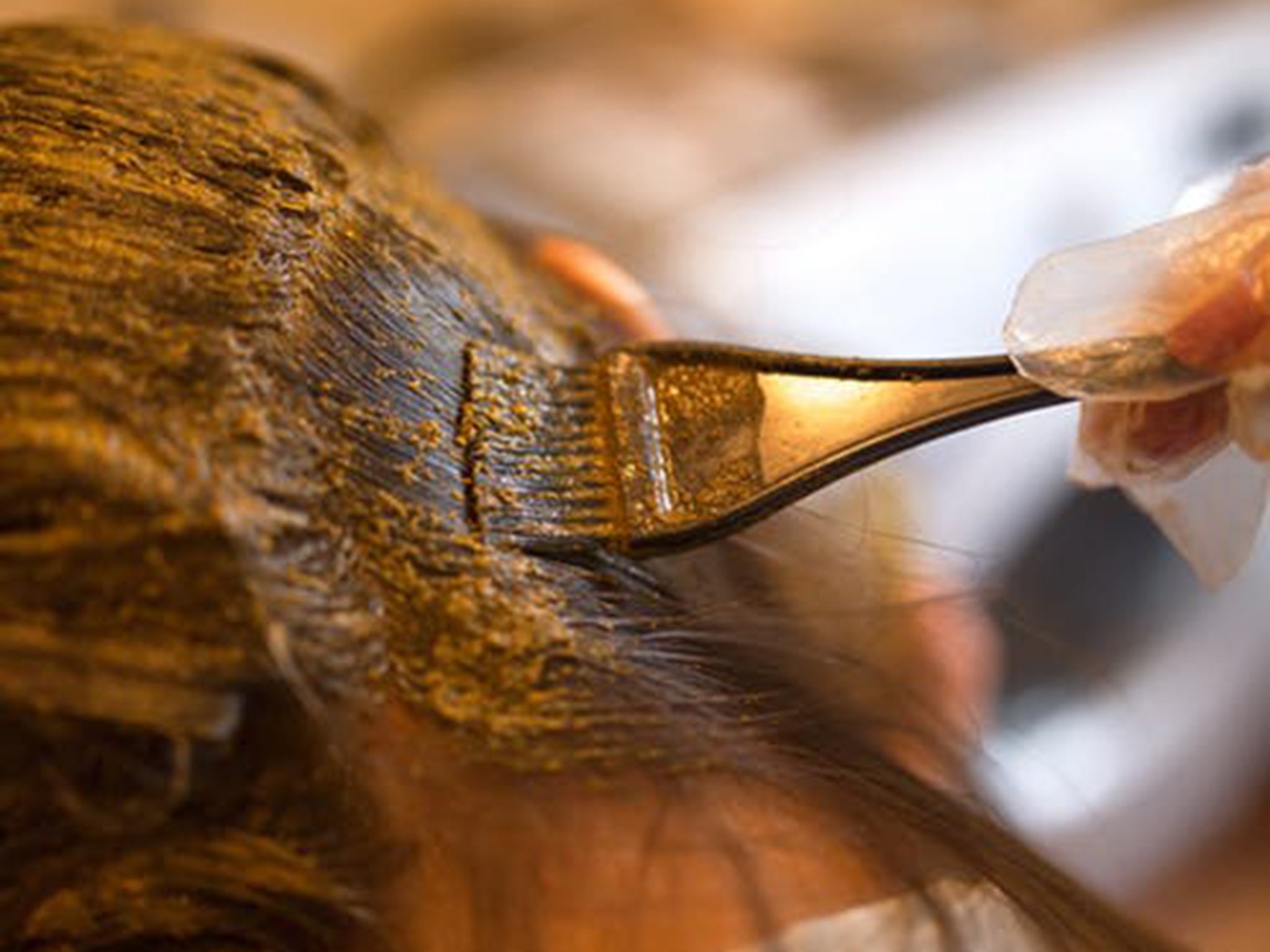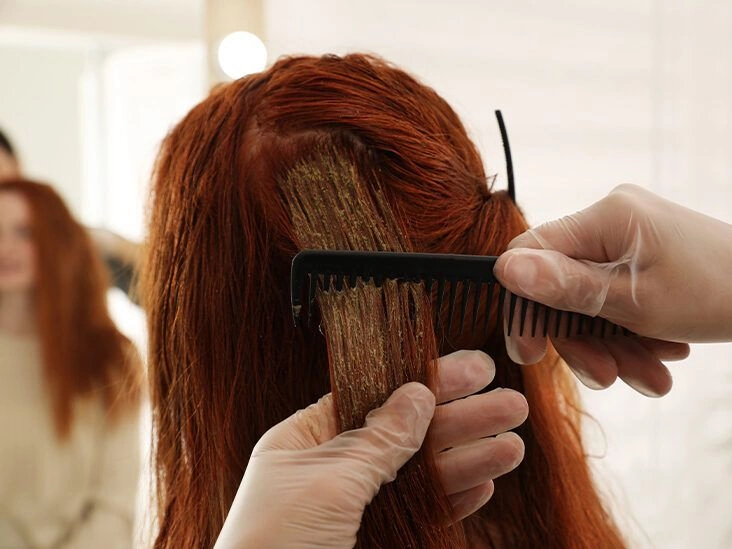Henna is famous for its vivid body art in South Asia and the Middle East, commonly called mehndi.
Did you realize it can also deliver shiny, deeply tinted hair?
Henna, referred to as mendhikā in Sanskrit, is widely used as a hair dye. It can also impart a smoothing sheen and intensify brown and auburn shades.
However, there are some drawbacks to using this plant-based powder on your mane. Let’s explore the advantages and disadvantages of dyeing hair with henna.
What is henna?

Henna comes from the leaves of the Lawsonia inermis plant. The dried leaves are powdered and usually made into a paste for application on hair or skin.
Traditional henna dye recipes involve drying the leaves into powder and mixing them with tannin-rich liquids like tea or coffee to boost their staining ability.
Henna contains lawsone, a molecule that binds to proteins to color hair, skin, and fabrics. It also has antibacterial and antimicrobial properties.
So why does this seemingly harmless plant raise concerns when used as a hair dye? Let’s review some of the downsides of henna.
Disadvantages of henna for hair
Although henna offers numerous benefits, it also has several disadvantages. Some are cosmetic, while others can be more serious.
Hard to change the color
Once you color your hair with henna, altering the shade is challenging. Generally, you’re left with the result you get.
Henna “will remain deeply in the cuticle and make it extremely difficult for your hairstylist to open the cuticle again and change the color,” says Monica Davis, a professional stylist and founder of My Straightener.
Lightening is difficult
Be cautious if you plan to lighten hair that’s been hennaed.
You can bleach hair colored with pure henna, but first confirm you used 100 percent henna powder or paste.
Many henna products contain additives, so confirming purity can be tricky.
It’s also necessary to wait for the henna to fade naturally; otherwise, bleaching can open the cuticle and intensify red-orange or dark undertones.
YouTuber Courtney Violetta documented attempting to bleach hennaed hair in this DIY video. The procedure was complex and required many products.
Ultimately, Violetta’s hair didn’t lighten as much as expected, and she reported strands became “stretchy,” dry, and brittle.
She later uploaded a video explaining why she stopped using henna entirely.
Generally speaking, your best option to remove henna dye is to let your hair grow out.
Best suited for dark hair
“Pure henna works best on dark hair,” says Salila Sukumaran, an ambassador for India’s health ministry and founder of the wellness travel consultancy Ayurgamaya.
On salt-and-pepper hair, henna can leave “a bright orange sheen,” Sukumaran notes.
If you want to hide gray hairs, a high-quality chemical dye may be a better choice.
May cause hair loss
Many people report hair shedding after henna use.
“Henna alone can’t cause hair loss, but low-quality or improperly applied henna may lead to dry hair and scalp and cause significant hair loss,” Davis explains.
Possible health side effects
As an Ayurvedic practitioner, Sukumaran warns that excessive henna use can create imbalances.
“Henna is very cooling and if a Kapha-type person… leaves a mask on longer than a couple of hours, they may become unwell,” she says.
Per Ayurveda, leaving henna on hair and scalp overnight may lead to:
- mucus accumulation
- colds and coughs
- neck and shoulder discomfort
Additionally, leaving henna on too long can dry and weaken the hair.
May react with metal
If you research henna, you’ll often find advice to avoid metal bowls.
This concern typically relates to iron or aluminum.
Davis notes that many modern commercial henna preparations are formulated to resist oxidation and don’t react with metal containers, but it’s hard to know if the product you have is protected.
Although scientific proof is limited regarding henna reacting with metal, it’s safest to mix henna in glass or ceramic bowls.
Advantages of henna for hair

Despite a long list of cons, henna still provides several benefits when used correctly.
Improves hair appearance
With the right ingredients, henna can boost shine, luster, and perceived strength.
“Thanks to its high tannin content, henna is effective against premature graying,” Davis says.
If you’re committed to the shade, henna may also deliver very durable color.
“Henna can produce a rich auburn shade that may last far longer than many chemical salon dyes,” Sukumaran explains.
Enhances hair health
Henna provides nutrients and protective benefits for the hair and scalp.
“It’s full of antioxidants, proteins, and has antifungal properties,” Davis says. “All three are helpful for dandruff-prone scalps.”
It can also supply a boost of vitamin E, a natural softening agent for hair.
Other potential wellness benefits
Sukumaran mentions that henna may offer Ayurvedic health advantages.
In Ayurveda, henna is considered cooling and may relieve headaches and reduce excess scalp oil.
Does henna “ruin” hair?
There’s a lot of online chatter suggesting henna will damage hair.
Sukumaran recounts a cautionary incident where a habitual henna user had burgundy hair bleached; the stylist did not employ a henna-compatible bleach.
According to Sukumaran, a chemical reaction between the henna and bleach caused the client’s hair to “smoke.”
Although the bleach was rinsed out immediately, the injury was done.
The silver lining is that if only the hair shaft is harmed, hair can regrow normally as long as the root remains intact.
While this is anecdotal, it highlights how potent interactions between chemicals and herbs can be.
Some henna users, including YouTuber ife360TV Naturally, report their hair looked damaged after repeated henna applications, noting texture changes and increased shedding.
Some henna mixtures can react badly with bleach or chemical dyes. Always inform your colorist if you’ve used henna and perform a patch and strand test to see how any dye will behave.
What to know before dyeing your hair

Given the drawbacks above, you might be ready to avoid henna. But before discarding it completely, understand why these issues arise and how to minimize them.
Whether henna suits your hair depends on factors such as:
- hair porosity
- hair texture
- use of conditioning agents
- application frequency
- duration of application
- allergies
- product quality
Porosity and texture
People experience henna differently because hair porosity affects how readily hair absorbs the dye and how it responds afterward.
Henna is most effective on very porous hair. Low-porosity hair may not accept the dye as well.
Those with curly hair might notice looser or less springy curls after using henna.
This occurs when lawsone molecules in henna coat the hair strand, altering porosity.
The coating also adds weight, which can loosen curl patterns.
More frequent henna use increases the accumulation of lawsone, deepening color but potentially flattening texture.
“Regular henna use can disrupt curly hair,” Sukumaran says. “Henna tends to form a film over the shaft, making strands appear straighter. If you have wavy or loose curls, repeated use may change your curl pattern.”
Preventing dryness
Henna can be drying.
“Even good-quality henna can make dry, frizzy hair drier,” Davis says.
She recommends countering this by adding moisturizers to the paste.
YouTuber Vyala Bloom concurs.
Bloom shares tips to restore curls, such as using a hibiscus tea rinse and avoiding protein-heavy conditioners like egg masks.
Frequency and duration of application
Repeated henna applications cause protein molecules to build up on the hair shaft.
This buildup can lead to heavier, less porous hair and altered curl patterns.
Sukumaran recommends keeping henna on for under an hour if you have curls or waves.
She notes her own curl products are less effective after extended henna treatments.
“Leaving henna on longer will alter hair texture to be smoother and straighter,” she says.
Allergies
As with any ingredient, allergic reactions to henna are possible, causing scalp irritation and redness.
There are also fake henna products on the market.
Black henna is often made using paraphenylenediamine, sometimes called PPD. PPD oxidizes to an indigo or blackish color when exposed to air, producing a dark stain.
However, it can irritate the scalp, causing:
- contact dermatitis
- burning sensations
- redness
- swelling
- itching
- flaking
- scarring
- blisters (in severe cases)
Many hair professionals develop contact dermatitis after regular exposure to this dye. Some, like Davis, consider black henna unsafe and won’t offer it in their salons.
Always do a patch test to screen for allergies before applying henna. Avoid black henna made with synthetic PPD.
Product quality
Beyond imposters, many henna powders, pastes, and blends may contain additives such as:
- silver nitrate
- carmine
- pyrogallol
- disperse orange dye
- chromium
These contaminants have been linked to:
- allergic responses
- chronic inflammatory reactions
- delayed allergic reactions to hairdressing products and textile dyes
What to use
In the commercial market, you have many henna options. Ready-made pastes are common, but it’s vital to choose high-quality products.
Davis is concerned about inconsistent quality control in henna offerings.
“Unscrupulous manufacturers may sell contaminated goods or add chemicals to cut costs,” she warns.
She avoids using henna on clients altogether.
If you decide to use it, she suggests selecting products that are:
- free of PPD
- free of pesticides
- free of additives
- safe for skin
Godrej Nupur Henna is one popular choice used by Bloom. Sukumaran recommends it because it’s blended with Ayurvedic herbs.
Many henna users also endorse Lush products or henna dyes from The Henna Guys.
In India, Shahnaz Husain products are popular and widely used.
The brand offers numerous Ayurvedic skin and hair products made from plant-based ingredients and herbs, along with recipes for pastes and masks.
Shahnaz Husain products include:
- henna powder
- indigo henna powder
- henna hair treatment powder suitable as a hair mask
Forest Essentials offers an Intensive Hair Repair Masque made with banana pulp, fenugreek, hibiscus, and other herbs to help combat henna-induced dryness.
Traditional henna dye recipes may call for tea or coffee to boost staining. If using pure henna, you might add ingredients such as:
- coconut oil
- amla powder
- hibiscus flower powder
- bhringraj powder
Plain henna powder can be the base for a customized paste, though it doesn’t mix easily with liquids and may be somewhat hard to work with.
If you go the DIY route, follow your henna recipe carefully and observe safety guidelines.
Aftercare
Post-dye maintenance is as important as preparation. Recommended steps include:
- Rinse henna thoroughly with water.
- Leave hair untouched for 24 hours.
- Shampoo and condition after the waiting period.
- Use a moisturizing hair mask.
“After applying a henna hair mask and rinsing it off, it’s best to leave hair alone for 24 hours,” Sukumaran says. “This helps the color deepen and allows the beneficial properties to integrate.”
She suggests waiting until the following day to shampoo and condition for best results.
Davis also advises using a nourishing, hydrating mask after henna treatments.
The verdict: Is henna bad for your hair?
As with any beauty procedure, it’s crucial to understand how your hair and skin might respond to henna.
Knowing the ingredients in your henna product greatly improves your chances of achieving healthy, vibrant color.
Research product safety and practice proper aftercare. Always perform strand and patch tests first to determine how your hair and skin will react.


















Leave a Reply
You must be logged in to post a comment.